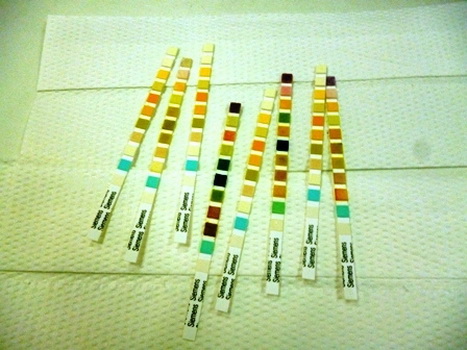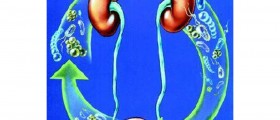
What Is A Urinary Tract Infection?
A urinary tract infection means that bacteria (common), virus or a fungus (rare) has entered and grown in the urinary tract causing symptoms and signs. An infection of the bladder is called cystitis. An infection in the urethra (urinal opening) is called urethritis, and an infection of the kidney is called pyelonephritis. Asymptomatic bacteriuria is the presence of more than 100000 colony-forming units of bacteria in a “clean catch” urine sample without causing any symptoms. A colony-forming unit is a unit of measurement of how many bacteria there are in a biological sample.
- Important notification about information and brand names used in this slideshow!
- Photo courtesy of New Media Ba by Picasa : lh4.googleusercontent.com/-AeoteQuhkoM/TYc11oVeGTI/AAAAAAAAHxA/erJ8DYnH_aI/s1024/cir.jpg
- Harrison's Principles of Internal Medicine
- Gynecology by Ten Teachers
- Obstetrics by Ten Teachers
- Oxford Handbook of Clinical Medicine

How Common Are Urinary Tract Infections?
Urinary tract infections are the most frequently seen bacterial infection in women. They mostly occur in women aged 16 to 35 years (child-bearing age group). Sixty percent of women get a urinary tract infection some time in their lives, while 10 percent get it annually. It is also the most common type of infection acquired in hospitals. Urinary tract infections occur four times more frequently in women than in men. Urinary tract infections have caused more than 7 million visits to the doctor’s office in USA alone in 2010. Asymptomatic bacteriuria is an incidental finding and its frequency rises from 7 percent during childhood to more than 50% in elderly individuals.
- Important notification about information and brand names used in this slideshow!
- Photo courtesy of New Media Ba by Picasa : lh6.googleusercontent.com/-glceeRHBoxc/TYcj-3Ur89I/AAAAAAAAHw4/78oCvb-BQBU/s1024/uretritis%2520a%2520z.jpg
- Harrison's Principles of Internal Medicine
- Gynecology by Ten Teachers
- Obstetrics by Ten Teachers
- Oxford Handbook of Clinical Medicine

What Are The Risk Factors For Urinary Tract Infections?
Female sex – Females are at a higher risk of getting a urinary tract infection than males. Females have a shorter tube leading to the outside from the bladder (urethra). The position of the opening of the urinary tract in the vulva close to the anus makes it easier for the gut bacteria to enter the urinary tract. Sexual intercourse – sexually active females get urinary tract infection much more readily. Honeymoon cystitis is thus named because it is common following marriage due to frequent sexual intercourse. Age – In post-menopausal women, the incidence of urinary tract infections is higher. In the female vagina there are bacteria that live in symbiosis (relationship beneficial to both) and protect against disease-causing organisms. Maintenance of this normal population of protective organisms requires estrogen; a hormone secreted in women before menopause.
- Important notification about information and brand names used in this slideshow!
- Photo courtesy of Brett Neilson by Flickr : www.flickr.com/photos/brettneilson/4727713967/
- Harrison's Principles of Internal Medicine
- Gynecology by Ten Teachers
- Obstetrics by Ten Teachers
- Oxford Handbook of Clinical Medicine

What Are The Risk Factors For Urinary Tract Infections?
Pregnancy – The incidence of urinary tract infections is higher in pregnancy. Pregnancy causes a general reduction in the body’s defenses against infections. In pregnancy, there is a higher production of a hormone called progesterone which increases the susceptibility to infections. Genital tract secretions which are ideal for bacterial growth also increase, and these can transfer infective agents into the urinary tract. In pregnancy there is a reduction in muscle tone in the bladder and the urethra, allowing the passage of infective agents into the bladder. Other risk factors – Diabetes melitus provides an excellent environment for the growth of bacteria. Therefore, urinary tract infections are more common in people with elevated blood sugar levels. Bed-ridden patients get urinary tract infections more frequently due to regular use of catheters and diapers. Uncircumcised males get urinary tract infections more frequently.
- Important notification about information and brand names used in this slideshow!
- Photo courtesy of New Media Ba by Picasa : lh5.googleusercontent.com/-XvepZOtRWC0/TYc1-mq3llI/AAAAAAAAHxA/IX4DqjKqi6Y/s1024/stomak.jpg
- Harrison's Principles of Internal Medicine
- Gynecology by Ten Teachers
- Obstetrics by Ten Teachers
- Oxford Handbook of Clinical Medicine

What Are The Causes Of Urinary Tract Infections?
Most urinary tract infections are due to bacteria that are normally found in the gut (gut commensals). Escherichia coli are the most common organism (80-85%). Staphylococcus saprophyticus causes around 5-10% of urinary tract infections. Klebsiella, Pseudomonas, and Proteus, are occasionally isolated organisms. These are unusual and are related to abnormalities in the urinary tract and instruments such as urinary catheters. Staphylococcus auerus can be transmitted through blood into the urinary tract. Viruses and fungi can cause urinary tract infections in individuals with severely weakened defenses such as AIDS patients, cancer patients, patients with uncontrolled diabetes, individuals on long term steroid therapy.
- Important notification about information and brand names used in this slideshow!
- Photo courtesy of pkdclinic by Picasa : lh3.googleusercontent.com/-Tcg1cmqI8dU/UVZMnqxSIkI/AAAAAAAAAlY/2cALIyrP93g/s800/aseptic-meningitis-symptoms.jpg
- Harrison's Principles of Internal Medicine
- Gynecology by Ten Teachers
- Obstetrics by Ten Teachers
- Oxford Handbook of Clinical Medicine

What Are The Features Of A Urinary Tract Infection?
Urinary tract infection symptoms can be mild to severe. Dysuria- This is a burning sensation while urinating, which can occur around the lower abdomen and/or lower down in the area between the legs (perineum). This can be either continuous or can be felt on and off only during urination. Frequency – The normal frequency of urination is around 2-3 times during the day and 2 times at night. In urinary tract infections this frequency will be much higher and the amount of urine passed each time you urinate will be small. The frequency of urination of a diabetic patient will also be high, but he will pass a lot more urine each time. Urgency – You might feel as though you will not be able to hold the urine in until you reach the toilet. Hematuria – Passage of blood with the urine is called hematuria. This may range from slight pink-tinged urine to full-blown red colored urine. It is very important to note that urinary tract infections and urinary tract stone can commonly cause hematuria with PAIN. It is very important to mention this relationship between pain and hematuria to your doctor because; HEMATURIA WITHOUT PAIN MAY BE A...
Urinary tract infection symptoms can be mild to severe. Dysuria- This is a burning sensation while urinating, which can occur around the lower abdomen and/or lower down in the area between the legs (perineum). This can be either continuous or can be felt on and off only during urination. Frequency – The normal frequency of urination is around 2-3 times during the day and 2 times at night. In urinary tract infections this frequency will be much higher and the amount of urine passed each time you urinate will be small. The frequency of urination of a diabetic patient will also be high, but he will pass a lot more urine each time. Urgency – You might feel as though you will not be able to hold the urine in until you reach the toilet. Hematuria – Passage of blood with the urine is called hematuria. This may range from slight pink-tinged urine to full-blown red colored urine. It is very important to note that urinary tract infections and urinary tract stone can commonly cause hematuria with PAIN. It is very important to mention this relationship between pain and hematuria to your doctor because; HEMATURIA WITHOUT PAIN MAY BE A FEATURE OF URINARY TRACT CANCER. Cloudy urine – Organisms, pus, and sloughed off lining cells of the urinary tract come out with urine and give the urine a cloudy appearance, when collected into a clear container. Pus in the urine is called pyuria. Flank pain – This occurs with pyelonephritis and upper urinary tract stones.
- Important notification about information and brand names used in this slideshow!
- Photo courtesy of Rossano Solic by Picasa : lh6.googleusercontent.com/-w1qMUoIl748/TpVBWOJYGJI/AAAAAAAAAJc/_jMlh8BgGsU/s1024/abdomen.jpg
- Harrison's Principles of Internal Medicine
- Gynecology by Ten Teachers
- Obstetrics by Ten Teachers
- Oxford Handbook of Clinical Medicine

Tests Done To Identify And Treat Urinary Tract Infections - Urine Full Report
Urine full report or urinalysis: The specific gravity (density) of urine is increased in a urinary tract infection. The appearance may be clear or cloudy. Urine color may be affected by the infection as well as by food, drugs and other factors. Epithelial cells may be present (In females >10 per high power field is taken as significant and in male it is >5 per high power field). Red cells may be present and any number is significant because red cells should not be in urine in a healthy individual. Organisms may also be seen in the urine sample, and these should be identified as disease-causing organisms and not commensals. Crystals in urine can hint towards the biochemical components of the urine as well as possible organisms.
- Important notification about information and brand names used in this slideshow!
- Photo courtesy of Iqbal Osman by Flickr : www.flickr.com/photos/82066314@N06/9200350863/
- Harrison's Principles of Internal Medicine
- Gynecology by Ten Teachers
- Obstetrics by Ten Teachers
- Oxford Handbook of Clinical Medicine

UTI Or Something Else?
Dysuria/Lower abdominal pain — This can also occur if you have pelvic inflammatory disease (also characterized by painful sex, vaginal discharge), ovarian cysts (can be indicated by irregular periods and heavy menstrual bleeding), cervicitis, vaginitis (expect vaginal discharge and an itchy vaginal area), miscarriages (usually with bleeding — watery or with clots), ectopic pregnancy (missed menstruation followed by severe pain and vaginal bleeding). Frequent urination — This can occur in diabetes mellitus (passing large amounts of urine, hungry and thirsty all the time). Heamaturia — This can occur with urinary tract stones (with pain), urinary tract cancers, dengue hemorrhagic fever, bleeding disorders, blood thinning drugs, and after radiation therapy (without pain). The combination of features and the pattern is vital. Therefore, mention everything you remember about the illness to the doctor, including family and past history of disease.
- Important notification about information and brand names used in this slideshow!
- Photo courtesy of Lab Science Career by Flickr : www.flickr.com/photos/lscareers/6303186548/
- Harrison's Principles of Internal Medicine
- Gynecology by Ten Teachers
- Obstetrics by Ten Teachers
- Oxford Handbook of Clinical Medicine

Tests Done To Identify & Treat Urinary Tract Infections: Urine Culture & Antibiotic Sensitivity
Urine culture and antibiotic sensitivity testing: Urine culture sample collection is very important because erroneous reports can lead to diagnostic mistakes. You need to wash the genitalia with soap and water first and dry the area thoroughly. Males should pull back the foreskin, and females should separate the vaginal lips. Let the first part of the urine flow out and don’t collect it in to the container. Collect the middle part of the urine flow in to your container. Close it tightly and hand it over to the lab. Don’t wash the container before collecting urine, as it is sterile. If the culture shows a growth, it will be analyzed under the microscope. Presence or >105 colony-forming units (in adults) is considered significant. The offending organism will also be identified and various samples or antibiotics will be tested against it. The most appropriate antibiotic will be suggested in the report. Your doctor may decide to do complete blood count, C-reactive proteins, ultrasound scan of kidneys, serum creatinine, blood urea nitrogen, serum electrolytes depending on the clinical judgment. Please remember that in urinary tract infection of children a different management plan needs to be implemented.
- Important notification about information and brand names used in this slideshow!
- Photo courtesy of Lotus Carroll by Flickr : www.flickr.com/photos/thelotuscarroll/8342134143/
- Harrison's Principles of Internal Medicine
- Gynecology by Ten Teachers
- Obstetrics by Ten Teachers
- Oxford Handbook of Clinical Medicine

Treating UTIs
General – You need to drink a lot of water because this results in the production of a large amount of urine which essentially washes the infection off. Simple and mild infections can be treated with good water intake alone. Please let your doctor decide. Acetaminophen (Paracetamol) is effective against lower abdominal pain and fever. Antibiotics – Antibiotics are the mainstay of treating urinary tract infections. The decision on what antibiotic to give is based upon multiple considerations. There are patterns identifiable locally with regards to the probable organisms and the best antibiotics they are sensitive to. Doctor will probably give you the antibiotic suggested in the sensitivity test report but if you have long standing kidney, liver diseases, allergies or if you are on other drugs which may interfere with the antibiotics the choice will change. It is very important to remember to LET THE DOCTOR DECIDE on the medication. Self-medication is dangerous.
- Important notification about information and brand names used in this slideshow!
- Photo courtesy of Vic by Flickr : www.flickr.com/photos/59632563@N04/6104068209/
- Harrison's Principles of Internal Medicine
- Gynecology by Ten Teachers
- Obstetrics by Ten Teachers
- Oxford Handbook of Clinical Medicine



























Your thoughts on this
Loading...